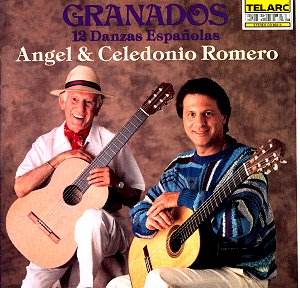In the nineteenth and early twentieth century
the guitar passed through a period of neglect on the international
musical scene, and leading Spanish composers were cautious about
writing for it. Even Fernando Sor (1776-1839), celebrated throughout
Europe as a player and composer, wrote little specifically Spanish-sounding
music and it was a relatively minor composer, Tarrega (1852-1909),
who prepared the way for the 20th century restoration
of the classical guitar. Maybe it was thought that only Spaniards
and gypsies would appreciate its possibilities, or possibly –
before Segovia arrived to change things – there were
simply not enough proficient classical guitar players to go around.
Nevertheless its voice resonates through this set of dances, and
how could it be otherwise since many of them stem from places
where the guitar has so long been revered. Originally written
for piano, and later partially orchestrated by Juan Lamote de
Grignon, it is therefore entirely appropriate for them to be arranged
for two guitars.
Granados took the easoer option of writing ‘picture
postcards’ rather than traditional works full of traditional rhythms
and colour. The Romeros seem so determined not to sentimentalise
them that their playing often sounds uncommitted, and in places
almost superficial. The technique is there in abundance, but these
delicate études call for a more relaxed approach. Though
there are moments of pure poetry, for example in the Villanesca,
we are left with a feeling that this respected duo has failed
to enter into the spirit of the music. These are, after all excellent
salon pieces and call for a relaxed and intimate approach.
A faster tempo is required in several dances,
such as Andaluza and the Jota, Rondalla Aragonesa,
where (despite a certain amount of sotto voce encouragement from
dad) brisker tempi and stronger rhythms are needed to bring out
their innate vitality. It all adds up to a curiously pallid performance
from players with so high a reputation for interpreting their
country’s music.
Roy Brewer
